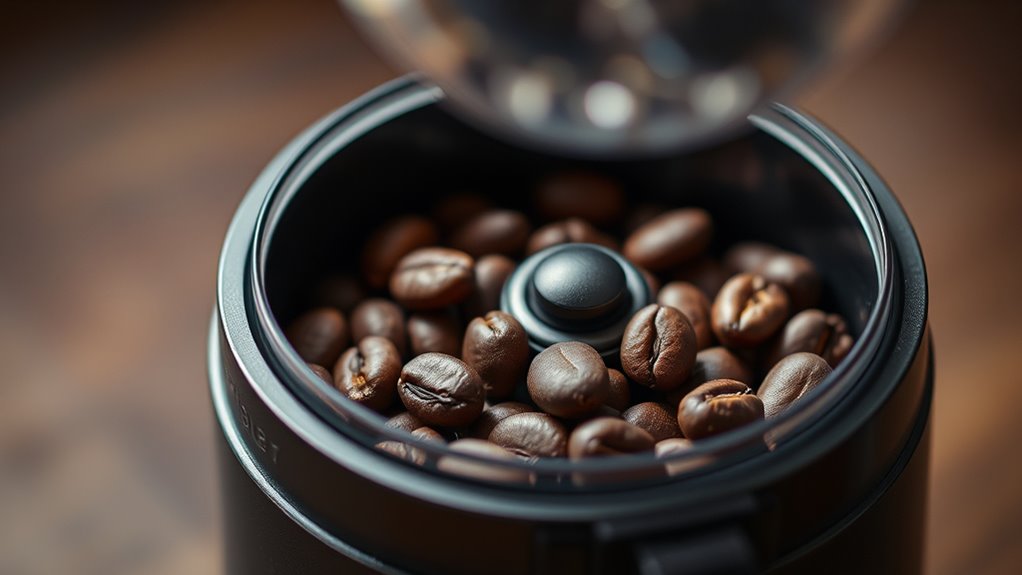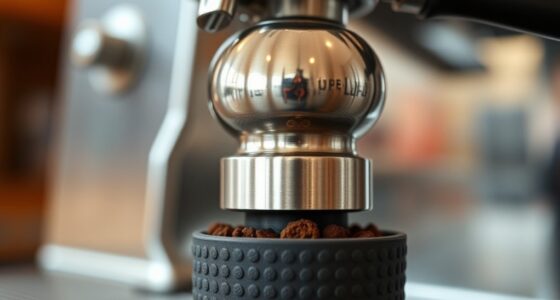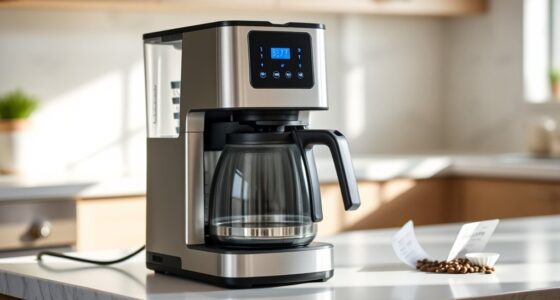Zero-retention grinders are designed to reduce leftover grounds inside the machine, which helps keep your coffee fresher and more aromatic. They use special features like efficient burrs, anti-static coatings, and precise dosing to prevent residual grounds from clinging and guarantee complete evacuation after grinding. While it’s not a magic fix for all freshness issues, minimizing leftovers can greatly improve flavor and aroma. Keep exploring to discover how these innovations can elevate your coffee experience.
Key Takeaways
- Zero-retention grinders are designed to minimize leftover coffee grounds, reducing stale flavors and ensuring fresher brews.
- They feature advanced mechanisms like precise dosing, anti-static coatings, and easy-to-clean components to prevent residue buildup.
- Zero-retention does not eliminate all residual grounds; regular cleaning is essential for maximum freshness benefits.
- These grinders help preserve aroma and flavor by preventing stale grounds from affecting new coffee batches.
- Not all users need zero-retention; its benefits are most noticeable for those seeking optimal freshness and minimal waste.
Understanding the Concept of Retention in Coffee Grinders
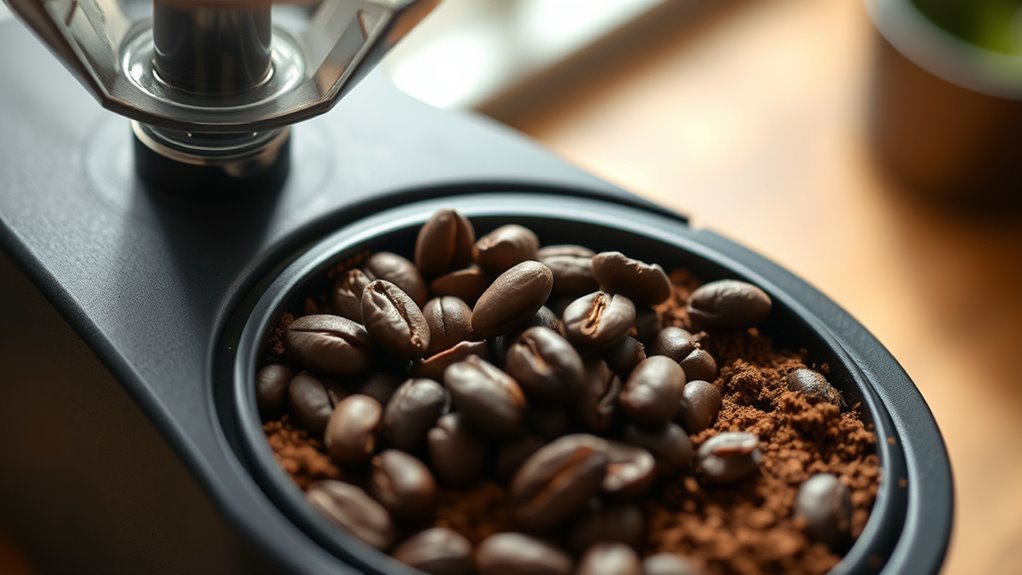
Understanding retention in coffee grinders is essential because it directly impacts the freshness and consistency of your brew. When your grinder retains coffee grounds, it can lead to stale flavors and uneven extraction. You might notice grinder noise changing as residual grounds build up, indicating accumulation inside the chamber. Additionally, the aesthetic design of a grinder can influence how easily you access and clean these retained grounds. A well-designed model minimizes retention by reducing corners where grounds can hide. This not only keeps your grinder cleaner but also helps preserve the aroma and flavor of each fresh grind. Being aware of retention helps you choose a grinder that maintains ideal freshness, ensuring every cup tastes as vibrant as it should. Proper maintenance and choosing vetted models can further reduce retention issues, enhancing your overall coffee experience.
How Zero-Retention Grinders Differ From Conventional Models
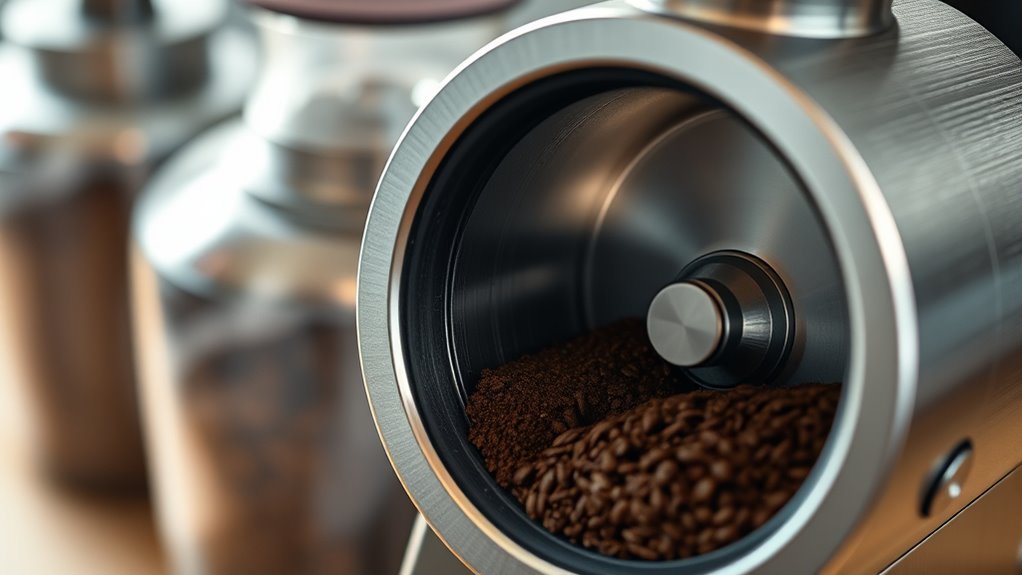
Unlike conventional coffee grinders, zero-retention models are engineered to minimize leftover grounds after each grind, ensuring you get the freshest brew possible. These grinders typically feature improved grinder ergonomics, allowing for smoother operation and easier cleaning, which helps prevent stale grounds from lingering. They often have precise dosing mechanisms that reduce waste and improve consistency. While zero-retention grinders tend to be more expensive, pricing considerations come into play, as you’re paying for advanced design and technology that prioritize freshness. Conventional grinders may be cheaper upfront but can leave behind residual grounds, compromising flavor. If freshness matters most to you, investing in a zero-retention model makes sense, especially if you prefer consistent results and less cleanup. Glycolic acid products are a good example of how targeted formulations can enhance skin radiance and texture, similar to how precise grinder design enhances coffee quality.
The Technology Behind Zero-Retention Designs

The key to zero-retention grinder technology lies in innovative design features that prevent leftover grounds from remaining inside the machine. One essential element is the grinder motor, which operates smoothly with minimal vibration and reduces grounds trapping. The motor’s efficiency ensures consistent grinding and quick clearance of grounds after use. Additionally, the burr material plays a critical role; high-quality, often stainless steel or ceramic, burrs are designed with precise geometries that minimize residue buildup. The shape and surface finish of these burrs facilitate easy cleaning and reduce the chances of grounds sticking. Furthermore, the incorporation of anti-static coatings can help prevent grounds from clinging to surfaces, enhancing cleanliness and ease of maintenance. Together, these components create a design that promotes complete ground evacuation, maintaining freshness and reducing waste. This advanced technology ensures your coffee stays fresh without lingering grounds contaminating subsequent brews.
Benefits of Using Zero-Retention Grinders for Coffee Freshness
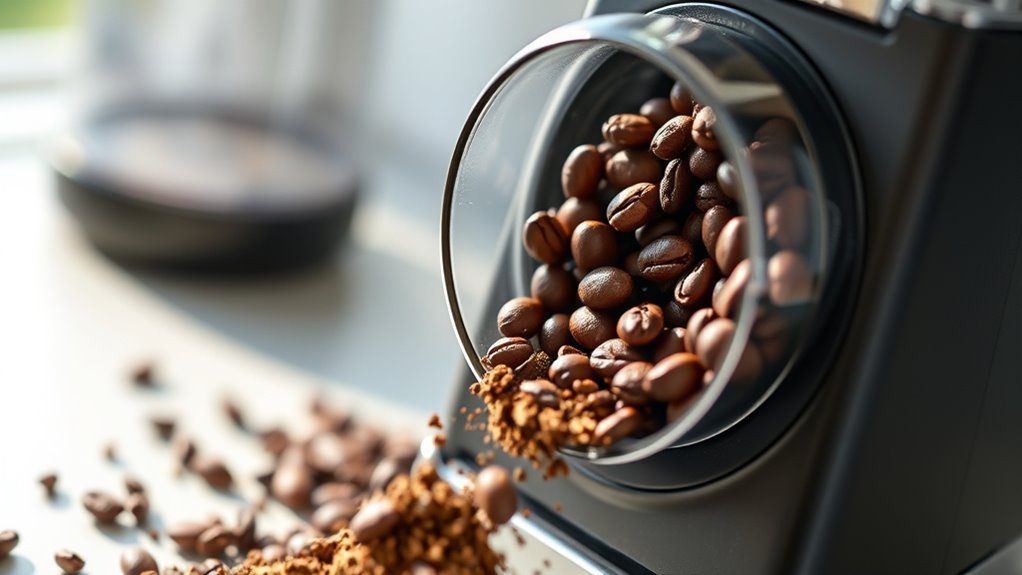
Using zero-retention grinders considerably boosts your coffee’s freshness by ensuring no residual grounds are left behind after each grind. This means your coffee remains flavorful and aromatic, as you’re using the freshest grounds possible for each brew. Plus, zero-retention designs help you control the exact amount of coffee you grind, reducing waste and improving consistency. When choosing a grinder, consider how grinder size impacts your brewing needs—smaller models are portable, while larger ones handle bigger batches. Price considerations also matter; zero-retention grinders can be an investment but often deliver superior freshness. Benefits include:
- Reduced stale coffee buildup
- Consistent grind size for ideal extraction
- Improved flavor clarity
- Less cleanup and mess
Wall organization solutions can further enhance your coffee station by keeping your tools tidy and accessible, contributing to an efficient brewing process.
Common Misconceptions About Zero-Retention Features
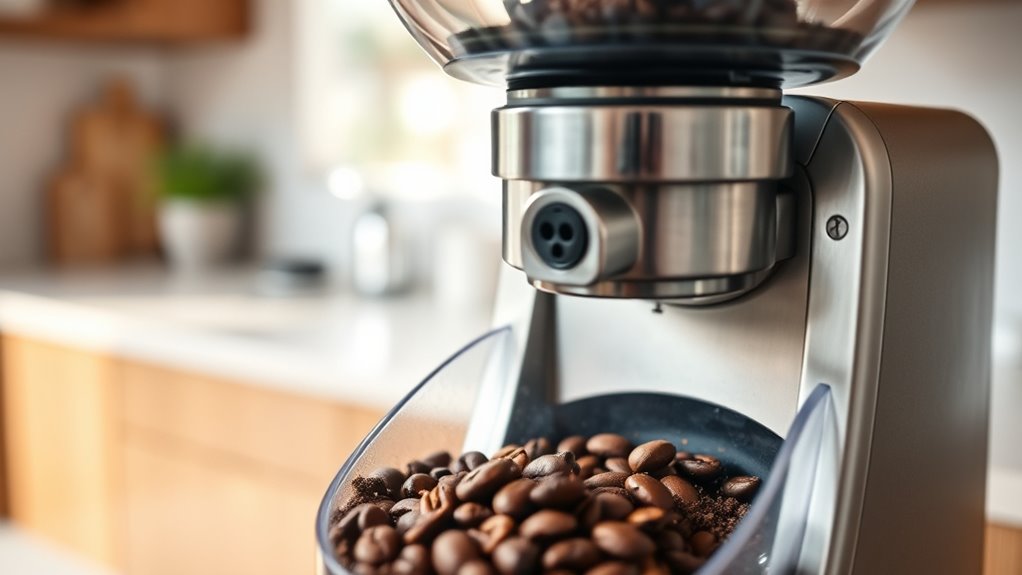
Many people assume zero-retention grinders eliminate all leftover coffee, but some residual amount always remains. You might also think they guarantee unrivaled freshness, yet other factors influence coffee quality more profoundly. Don’t forget, proper maintenance is essential to keep these grinders performing at their best, even with zero-retention features.
Misinterpreting Zero-Residual Claims
Misinterpreting zero-residual claims often leads to misconceptions about what zero-retention features truly offer. Many think that zero-retention grinders guarantee completely fresh grounds every time, but that’s not always the case. While these grinders do minimize leftover coffee in the burrs, it doesn’t automatically mean your brew will taste fresher if you don’t consider other factors. It’s easy to assume that zero-residual equals perfect freshness, but your brewing techniques and the quality of your coffee gear matter just as much.
Additionally, proper cleaning is essential to maximize the benefits of zero-retention technology and ensure optimal brewing results.
Overestimating Freshness Impact
While zero-retention grinders are designed to minimize leftover coffee, it’s a common mistake to assume they automatically guarantee fresher grounds with every brew. Many buyers focus on price comparison and assume they’re getting the best value for fresher coffee. However, these grinders mainly reduce residual grounds, not necessarily improve overall freshness. The aesthetic design may look sleek, but it doesn’t influence how quickly coffee loses flavor once ground. Freshness depends on how you store your beans and brew schedule, not just the grinder’s features. Overestimating this impact can lead you to overlook more critical factors like storage conditions and timing. Remember, a zero-retention grinder helps, but it’s only one piece of the freshness puzzle.
Ignoring Maintenance Requirements
Zero-retention grinders are often praised for their ability to reduce leftover grounds, but their maintenance needs can be overlooked. Many users assume these machines require minimal upkeep, leading to maintenance neglect. This neglect can cause issues like clogs, inconsistent grind size, or even damage, which may void warranty coverage. To keep your grinder performing impeccably, consider these points:
- Regularly clean burrs and chambers to prevent buildup
- Follow manufacturer’s maintenance schedule diligently
- Use recommended cleaning tools and solutions
- Address minor issues promptly to avoid costly repairs
- Incorporating proper meditation routines can enhance your overall focus and ensure attentive maintenance habits.
Ignoring maintenance requirements not only risks damaging the grinder but also raises warranty concerns if problems arise from neglect. Staying proactive ensures longevity, consistent performance, and peace of mind.
Evaluating the Practical Impact on Flavor and Aroma
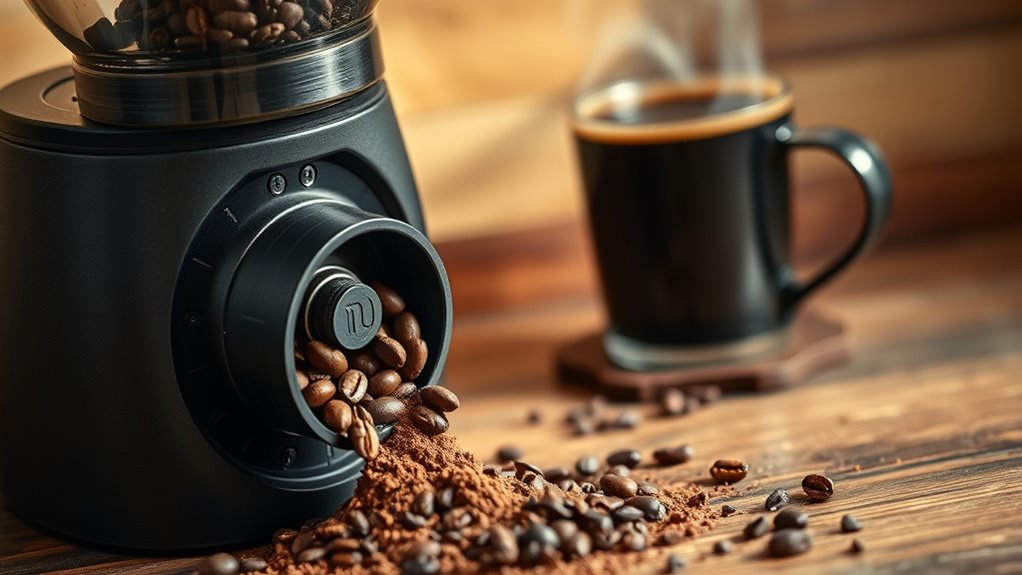
Evaluating the practical impact of zero-retention grinders on flavor and aroma reveals that, despite their technical design, the differences are often subtle but meaningful. Since ground coffee is highly sensitive to exposure, even small amounts left in a grinder can affect freshness over time. Zero-retention grinders minimize residual coffee, helping preserve aroma during storage and reducing stale flavors. When you grind fresh beans, the better aroma preservation means your coffee retains its vibrant scent longer, enhancing overall flavor. While the improvements may not drastically change every brew, they do support a fresher, more nuanced coffee experience. Understanding narcissistic traits how a zero-retention grinder influences these factors can guide your choice and routine, especially if you value maximum aroma and freshness.
Choosing the Right Grinder: Is Zero Retention a Must?
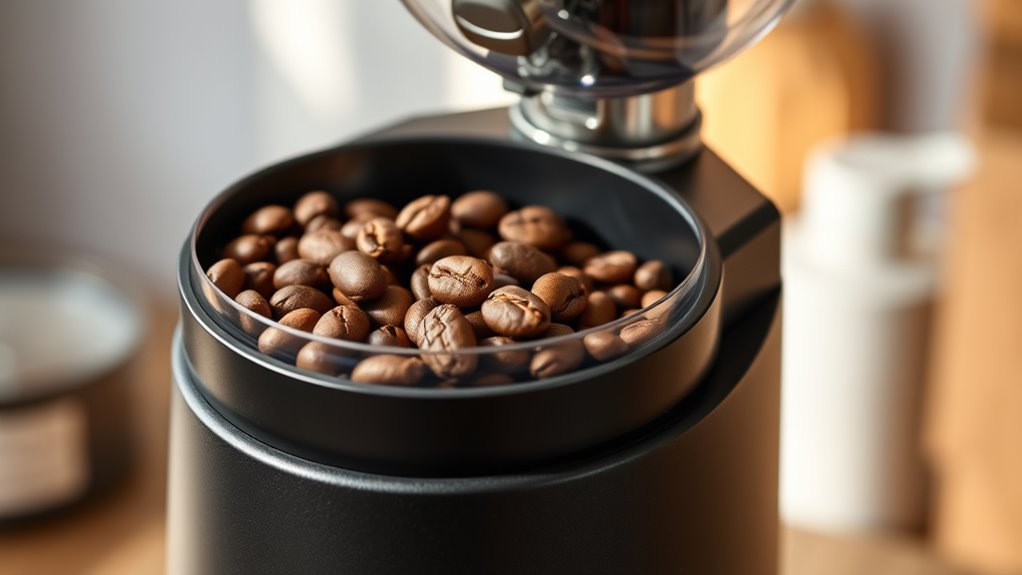
Choosing the right grinder involves weighing your priorities for freshness, flavor, and convenience. Zero-retention grinders are popular, but they’re not a must for everyone. Consider your needs: if you value quick cleanup and minimal waste, a lightweight grinder might be ideal. Look at color options to match your kitchen style or personal preference. Also, think about grinder weight—heavier models often feel sturdier and may offer more consistent results. Additionally, some grinders are designed with preppy dog names in mind, reflecting a stylish aesthetic that can complement your kitchen decor.
Maintenance and Care for Zero-Retention Coffee Grinders

Regular maintenance is essential to keep your zero-retention coffee grinder performing at its best. Proper cleaning reduces grinder noise and ensures consistent grind size, which preserves freshness. To maximize user ergonomics, handle the grinder gently and position it conveniently for daily use. Regularly inspect and clean burrs and chambers to prevent clogging and residue buildup. Avoid forcing parts, as this can damage the mechanism. Use the table below to guide your maintenance routine:
| Task | Frequency | Tools Needed |
|---|---|---|
| Clean burrs | After every 100 uses | Brush, soft cloth |
| Lubricate moving parts | Monthly | Food-grade lubricant |
| Check for wear | Quarterly | Inspection mirror |
| Deep clean chamber | Every 2-3 months | Vacuum, soft brush |
Consistent care keeps your grinder quiet and user-friendly, ensuring maximum freshness.
Frequently Asked Questions
How Much Does a Zero-Retention Grinder Typically Cost?
A zero-retention grinder usually costs between $200 and $800, depending on the brand options you choose. Higher-end brands offer more precise grinding and better build quality, but you can find more affordable models within this range. Keep in mind that investing in a quality zero-retention grinder guarantees fresher grounds and better flavor, making it worth considering your specific needs and budget when selecting the right one for you.
Are Zero-Retention Grinders Suitable for Commercial Coffee Shops?
Did you know that 70% of successful coffee shops prioritize equipment that boosts workflow efficiency? Zero-retention grinders are ideal for this, as they minimize grind waste and speed up service. However, they can be more complex to maintain, which might increase downtime. For a busy commercial setting, weigh the benefits of freshness and efficiency against maintenance complexity to decide if a zero-retention grinder fits your shop’s needs.
Can Zero-Retention Grinders Handle All Coffee Bean Types Equally?
You might wonder if zero-retention grinders can handle all coffee bean types equally. They excel at maintaining grind consistency because they minimize residual coffee, helping preserve freshness. However, proper coffee bean storage is vital, as different beans may require specific grind settings. While zero-retention grinders are versatile, you should adjust your grind based on bean origin and roast level to guarantee ideal extraction and flavor.
Do Zero-Retention Grinders Require Special Cleaning Procedures?
Zero-retention grinders do require specific cleaning procedures to keep them functioning at their best. You should perform regular cleaning frequency based on how often you use the grinder, especially if you switch beans frequently. Maintenance procedures involve brushing out residual grounds and occasionally disassembling parts for a thorough clean. This ensures consistent grind quality and prevents flavor contamination, making your grinder more efficient and prolonging its lifespan.
Are There Any Downsides to Zero-Retention Grinder Technology?
You might wonder if zero-retention grinders have downsides. They can sometimes lead to higher future maintenance because their complex mechanisms may require more frequent upkeep. Additionally, some models produce increased noise levels during operation, which could be disruptive. While they excel at keeping beans fresh, consider these factors to guarantee they fit your needs. Evaluating noise and maintenance needs helps you choose a grinder that balances performance with practicality.
Conclusion
Think of a zero-retention grinder as a fresh start for your coffee routine, clearing away yesterday’s leftovers to reveal today’s true flavor. By embracing this innovation, you release the potential for brighter, more vibrant aromas with each brew. Remember, it’s not just about the machine—it’s about honoring the journey from bean to cup. When you choose zero retention, you’re inviting pure freshness to dance in every sip, making each cup a new beginning.
